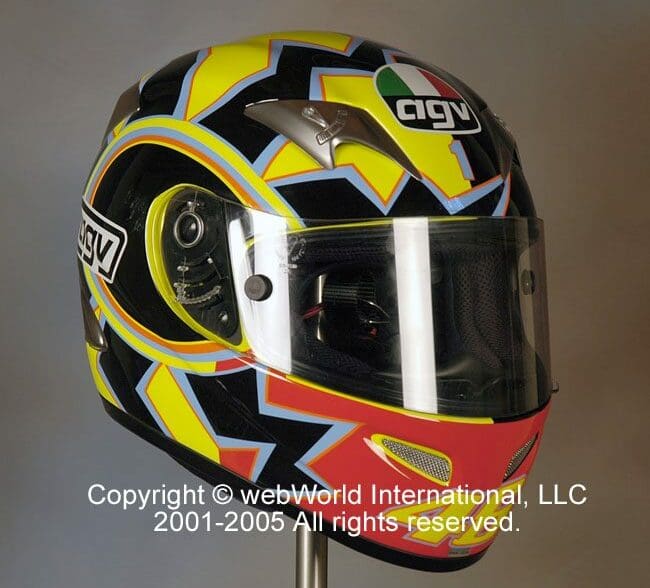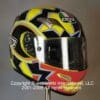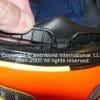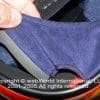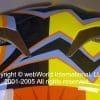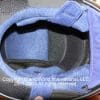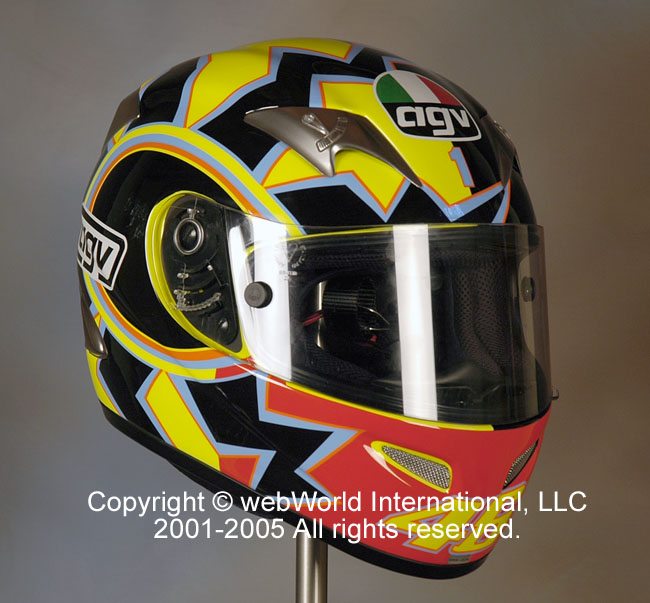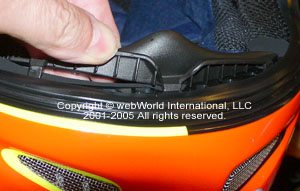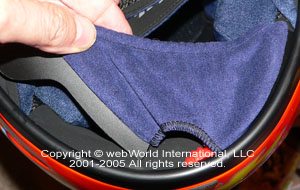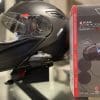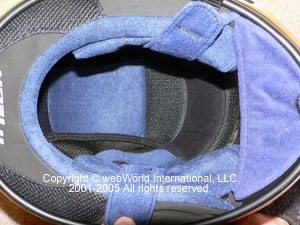AGV is a very familiar name to motorcycle riders around the world.
The company AGV (Amisano Gino Valenza) was established in 1947 as a manufacturer of leather seats and bicycle saddles.
Gino Amisano was a motorcycle industry visionary, having pioneered the concept of motorcycle racer endorsements.
I first remember seeing the bold AGV logo on Barry Sheene’s helmet in the ’70’s, and I’ve been enamored with those three letters ever since.
The list of motorcycle racers wearing AGV helmets reads like the Hall of Fame for the sport.
In addition to Sheene, AGV racers include the likes of Giacomo Agostini, Johnny Ceccotto, Randy Mamola, Troy Corser and many, many more.
Including, of course, Our Hero — and the inspiration for the AGV Ti-Tech, Valentino Rossi.
If Rossi left for Formula 1 tomorrow (a 2007 Ferrari ride has been rumored), he has already confirmed his position as one of the all-time greats of motorcycle history. He’s certainly on my short list of super heroes.
I’ve been following his career since the beginning of the 125cc days, so when I first laid eyes upon one of the AGV Rossi replica helmets, I knew I’d have to own one.
Graphics
Trying to decide between the VR46 “Rossi 46” version (shown here) or the Rossi MotoGP graphics was an excruciatingly hard decision.
But I’m partial to strong but simple graphical statements, and the powerful and perfectly applied black, yellow and orange jagged edges really does it for me. Who knows — maybe I’ll end up with both models someday. Do you think maybe I could convince Vale to autograph one for me?
I like the graphics enough that if I never wore the helmet and just sat it on a shelf to admire it, I’d be happy. Unfortunately, that may be its fate, due to what we think is a strange sizing problem, which we’ll get to in due course.
By the way, the bright colors are also a safety feature, because this helmet really stands out in a crowd and gets some very admiring looks from other riders (Bonus: that’s the excuse you can use when your significant other finds out you’re about to blow $650 on … a motorcycle helmet?).

Weight: Ti-Tech = Titanium?
We’re not sure if the “Ti” in Ti-Tech is a gimmick. Other than the titanium vent covers on the top, rear and sides, we could not find any other use of the metal anywhere in the helmet.
AGV’s marketing blather might lead one to believe that the shell includes some titanium, but we’d be hard pressed to believe it, because titanium is too stiff and brittle to offer the type of energy absorption necessary to decrease impact loads.
Sure, the titanium covers look cool, but they’re probably no lighter than an equivalent piece of plastic, and probably not as light as carbon fiber. We’ve added a Ti-Tech slide show to this article, which includes some detailed close-up photos of the titanium vents, so take a look and see what you think.
I’ve worked with titanium as a machinist in a previous life, and it is not a metal that can take a great polish, like aluminum. So the covers sort of end up looking like they were painted with semi-matte silver. I wonder how many will really know what finished titanium looks like?
Do yourself one favor: do NOT slide your fingers along the edges of the titanium vent scoops! Ours have a very sharp edge that put a large cut across the finger of a leather glove.
The use of titanium doesn’t seem to do anything to make the helmet lighter. The size XXL Ti-Tech (why an XXL? More on this later…) weighs in at 1582 grams, or 3 lbs., 7-3/4 oz. on our Polder scale. Check out the webBikeWorld Motorcycle Helmet Weight Comparison page to see how that stacks up next to all of the other helmets we’ve reviewed.
Because of the sizing, it’s somewhat like comparing apples to oranges, but the Ti-Tech is at the lower end of the weight scale, keeping company with some of the most lightweight helmets in the webBikeWorld stables.
It’s still not as light as the lightest helmet we feel safe wearing, the CMS GP-4, but we have no complaints, and if all full-face helmets were as light as the Ti-Tech, we’d be happy. The XXL doesn’t actually feel super-light weight, but I bet a medium would.

Sizes
Now about that sizing issue… Of the crew that assists with webBikeWorld evaluations, two have almost identical head shapes (round) and wear the same size helmet (XL) in almost every brand on the market. If you’ve ever wondered, that’s why the majority of the helmets we review are size XL. One reviewer wears a size L and has an oval head shape.
When we placed the order for the AGV Ti-Tech and the Suomy Extreme for this comparison review, we specified size XL for both and thought nothing more about it. The Suomy fits as expected for its size, and it’s just on the oval side of a round head shape (see the wBW Motorcycle Helmet FAQ page for more information on head shapes and helmet fitment).
But when the Ti-Tech arrived, we were very surprised to find that the size XL fit like a size medium — two sizes small. It was so small that two of us couldn’t even fit it over our heads. We haven’t run into this problem before, and we assumed that our example was possibly labeled incorrectly at the factory.
Although helmet sizes and head shapes definitely vary among manufacturers, even between different models from the same manufacturer, the difference in this case was simply too drastic to be accounted for by anything but a very unusual problem. Or so we thought…
So the XL was packed up, a return authorization number was acquired and an XXL was ordered as a replacement. The Ti-Tech is manufactured in two different shell sizes and the helmet is available in a range of sizes from XXS to XXL, with a “medium small” (MS) and “medium large” (ML) in between.
AGV must figure that most of the Ti-Tech’s prospective owners will be young men in their teens and early twenties, and developed their range of sizes accordingly. Two shell sizes are used to cover this range.
UPDATE: The TiTech uses AGV’s “race fit”, which is more snug than their street helmets.
The XXL arrived — the first time we’ve ever had to order a motorcycle helmet larger than XL — and guess what? It fits like a size large. There’s no doubt about it, even though the retailer where we purchased the helmets was adamant that AGV’s sizing is the same as any other brand.
We can only assume that the problem is a result of AGV’s helmet shell design, with the large sized shell being much smaller than normal, probably to account for the wider variety of middle sizes. The bottom of the helmet shell on the XL and the XXL is very narrow, making it especially painful to get the helmet on and off over a large sized head.
Long story, but the bottom line is that the AGV Ti-Tech, in our opinion, does not have anywhere near a standard sizing range when compared to Shoei, Arai, HJC, KBC, OGK, Suomy and many others. The AGV Ti-Tech fit is unlike any other motorcycle helmet we’ve tried.
Our advice is this: if you normally take a size XL or larger helmet, the AGV Ti-Tech might not be for you. But if you normally take a size large or smaller, and if you’ve always wished for a wider range of medium sizes, you’ll probably be in heaven.
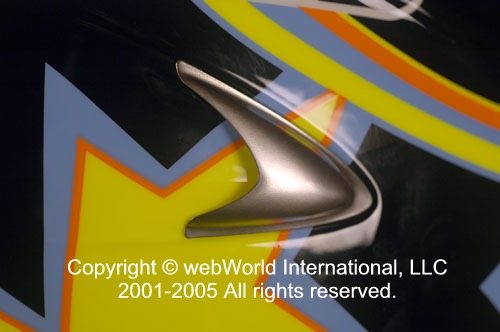
Ventilation
Those titanium top vents use a simple on/off lever to allow the air to flow in, through the vent and into the helmet and over the top of the rider’s head. Unlike other helmets that have a rear exhaust not directly connected to the intake, the Ti-Tech’s liner gives the air a straight shot through the front and out the back.
Mesh covered channels on top of the rider’s head allow the cooling breezes to do their thing. Both are covered in a metal (bronze?) mesh that looks exactly like the stuff used on a household screen door. It’s non-removable and can be a pain to clean when full of bugs.
The vents direct air through the back of the chin bar, where the air pushes through the fabric liner material. This helps to increase air flow to the rider’s face, but limits the amount of defogging air that might be otherwise directed through the chin bar and on to the back of the clear face shield.
Two small side vents, located behind and beneath the rider’s ears, ostensibly serve as low-pressure exhaust outlets for the air that enters the helmet through the chin vents.
We’re of mixed opinions on the appearance of the mesh; some think it looks cool, others think it looks cheap. Everyone agrees on one thing: it’s definitely different. The rear exhaust vents are also covered by the mesh. They’re open for business 24/7, with no lever provided (nor needed) to close them.
You’ll notice when studying the photographs in the Ti-Tech slide show that the chin vents do not have the typical lever or switch on the outside.
The Ti-Tech has a unique back/forth horizontal switch underneath the chin guard, just inside and below the center, under Rossi’s number 46. The switch is very balky on our example and it seems to be very reluctant to move when the helmet is being worn.
This may be a result of extra friction added when the shell is stretched, as it would be when it’s on the rider’s head. Since we almost always leave the vents open anyway, this problem isn’t too serious, but the Ti-Tech loses a few points for execution. Also, the location of the switch means that it’s not easy to remember that open is to the right and closed is to the left.
In any case, the absence of external moving parts definitely gives the helmet a sleek and unique look. Overall, the Ti-Tech’s venting system is simple but effective, and although the jury’s still out on the chin vent switch, the combination of the top levers and the titanium vent covers seem like they’ll last forever.
Bottom line? The Ti-Tech’s venting system works, but not as well as the Suomy Extreme, and nowhere near as good as helmets with the highest volumes of air flow, such as the Shoei X-11 and others. The King of Air Flow, in our opinion, is still the late and lamented OGK FF-3, one of our all-time favorite helmets (RIP).
The top front vents generate some high-frequency “whistling” type noises.
The sounds are most noticeable at certain angles of attack; in the case of the Ti-Tech, the noise is most noticeable when the rider is sitting in a forward lean.
This is bad news for sportbike owners, who certainly constitute the target market for this helmet. The noise definitely comes from the top vents, because it can be easily silenced with a hand over the vent.
High frequency whist
ling noises seem to be a problem with several helmets we’ve tried recently.
The incorporation of complex air scoops into the top of the helmet is usually the culprit. Manufacturers apparently feel that a helmet won’t sell unless it has Star Wars style vents.
I’ll bet there are much more efficient and aerodynamic designs that are less complex, but they probably wouldn’t sell because they don’t look cool.
All you have to do to understand why a poorly designed vent causes noise is to blow air over the top of a soda bottle — you’ll instantly understand how this type of noise is generated. There’s got to be a better way, no?
All things considered though, we have to remember that the Ti-Tech is a race-inspired helmet, where function takes precedence over luxury. And for a race helmet, the Ti-Tech is relatively quiet. It’s definitely quieter than the Suomy Extreme, but the sound type, or quality, is different.
See the wBW Motorcycle Helmet Noise page for more information on the causes of helmet noise and for a sample MP3 download and sine wave graphic of the AGV Ti-Tech and Suomy Extreme helmets.
The Ti-Tech seemed less susceptible to the low frequency “booming” noises caused by windscreen turbulence around the lower neck area of the helmet. The Extreme is very noisy in this regard, probably because the fit under the chin and around the neck is not as tight as the Ti-Tech.
This is surprising, since the shell is smaller than normal, and the helmet fits very tightly around the neck area, which should block most of this noise.
Remember that we always wear high-quality, correctly fitted earplugs on every ride, along with a cloth helmet liner. Your experiences may differ, but we strongly urge you to wear earplugs to avoid permanent hearing loss. See the wBW Earplugs and Hearing Protection page for more information on choosing and fitting earplugs.
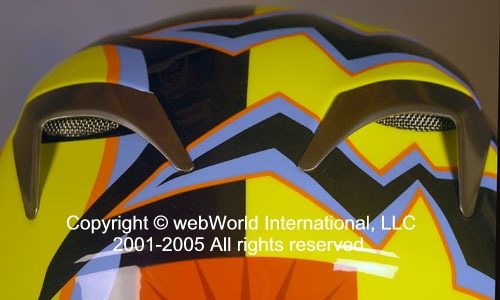


Face Shield
The Ti-Tech uses a fairly typical face shield, with 9 detents to hold it in various positions. We are not pleased with the design, because the face shield feels thin and it’s flimsy. Push on the tab on the left-hand side to open it and the face shield twists as it rises, which is usually a sign of too-thin face shield material or poor design or both.
Frankly, it’s not much better than the face shield on the very inexpensive Zamp helmet we reviewed recently, and certainly not worthy of a $675.00 helmet. The Suomy Extreme face shield seems stronger and doesn’t twist when opened. It also has a locking snap that is designed to keep the face shield from blowing open at speed, a feature strangely missing from the Rossi Ti-Tech.
Helmet Liner
The Ti-Tech’s liner is relatively comfortable; certainly not as comfortable as last year’s webBikeWorld Helmet of the Year, theShark RSR, which has the most comfortable liner we’ve ever tried.
The Ti-Tech’s liner is about average; if we had to compare it, we’d say it’s similar in comfort to the recently reviewed HJC CL-14.
Miscellaneous
The padding on the TiTech is removable and washable and the liner is made from Cool Max liner.
The face shield is claimed to be anti-fog treated, but it seems to fog up more quickly than other helmets we’ve tried. The sides of the face shield lay over the helmet and the face shield can be removed without tools.
By the way, the Ti-Tech seems shorter in the front-to-back dimension than we’d expect, especially considering it’s a size XXL. Riders with large chins may find a shortage of room in this critical area.
The Ti-Tech uses a D-ring retention system (kudos for that!). AGV includes a three year warranty with the helmet.
Conclusion
Which brings us to our overall opinion on the AGV Ti-Tech: our feeling is that this helmet is more about style and image than it is about function.
The face shield, the venting, the liner and some of the features like the ill-fitting chin air curtain and the breath guard that refuse to stay put on our example have downgraded our opinion, especially considering the price. It’s easy to overlook some of these faults on a $200 helmet, but not on one costing over 3 times as much.
Maybe the faults wouldn’t have been as noticeable if we weren’t comparing the Ti-Tech to the Suomy Extreme in this paired review. We wore each helmet back-to-back on every ride, and our feeling is that the Suomy wins this comparison. You’ll have to read the review of the Suomy Extreme to learn more; just because it beat the Ti-Tech doesn’t mean that it’s without fault also.
The AGV Ti-Tech has a wonderful graphic design and it isn’t a bad helmet, but we can’t help but think that without the gimmicky titanium vent covers and the Rossi paint that it’s much more like a $300.00 helmet than one costing $675.00.
| wBW Review: AGV TiTech Helmet | |
|---|---|
| Manufacturer: AGV | List Price (2005): $649.95 |
| Colors: Rossi graphics, graphics and solids. | Made In: Italy |
| Sizes: XXS – XXL | Review Date: September 2005 |
| Homologations: BSI and DOT safety standard. | |
Owner Comments and Feedback
See details on submitting comments.
From “D.P.”: “I agree with what you’ve said regarding the strange sizing of this helmet. I normally take a size medium in almost every helmet I buy, but when I tried on the AGV TiTech, I couldn’t get my head into the size medium and even the size large was too tight!!!
The reason for my writing to you though, is to say that the strange sizing seems to only affect the AGV TiTech. Other AGV helmets I’ve tried on (Stealth and Airtech), seem to fit me fine in a size medium. This could be why the retailer you purchased the helmet from was “adamant that AGV’s sizing is the same as any other brand”.
Just a thought. Love the website and all the reviews.”
Also from D.P.: “A little while ago I wrote to you regarding the strange sizing of the AGV TiTech. Well, I found an AGV size chart on the American website that proves my theory. The strange sizing does only affect the TiTech. It doesn’t affect any other helmet in the range. Have a look at (this size chart) for yourself.”
From “T.M.”: “Had my “Duck” serviced at Del Amo Motorsports in Redondo Beach, CA today. While I had plenty of time (WAAAY plenty of time…waiting…and waiting…AND waiting…) to kill, I naturally browsed through their parts/accessories dept. I learned they had jettisoned Vemar helmets (blowing them out at just $99/ea.!), and were now carrying another Italian brand, AGV (“Valentino Rossi’s Favorite!”). But upon further review, the labels said “MADE IN CHINA”, not Italy! MAMA MIA! Does “The Doctor” even know about this?
So, I made a mental note to here on out cross “AGV” off my list of potential suppliers the next time I want a “lid”. I also e-mailed AGV this afternoon, registering my displeasure at them for basically cheapening their brand and image, and also putting free-market ITALIAN manufacturing workers out of jobs.
On the other hand, I’m glad to see that MADE-IN-GERMANY Craft Helmets are now available state-side, AND they’re the only co. to be certified to ALL major international safety standards (and priced MUCH less than Arai and Shoei, and less than AGV and other cheap Asian brands, too boot!). Plus, another Italian company, Airoh, is making plans to enter the U.S. market, and there’s always Suomy and Nolan/X-lite, for those who prefer to be outfitted Latin-style, while CMS offers a PORTUGESE way of head protection.
You’re correct in stating it’s hard trying to find items NOT made in China … but with a little consumer diligence, IT CAN BE DONE.”


